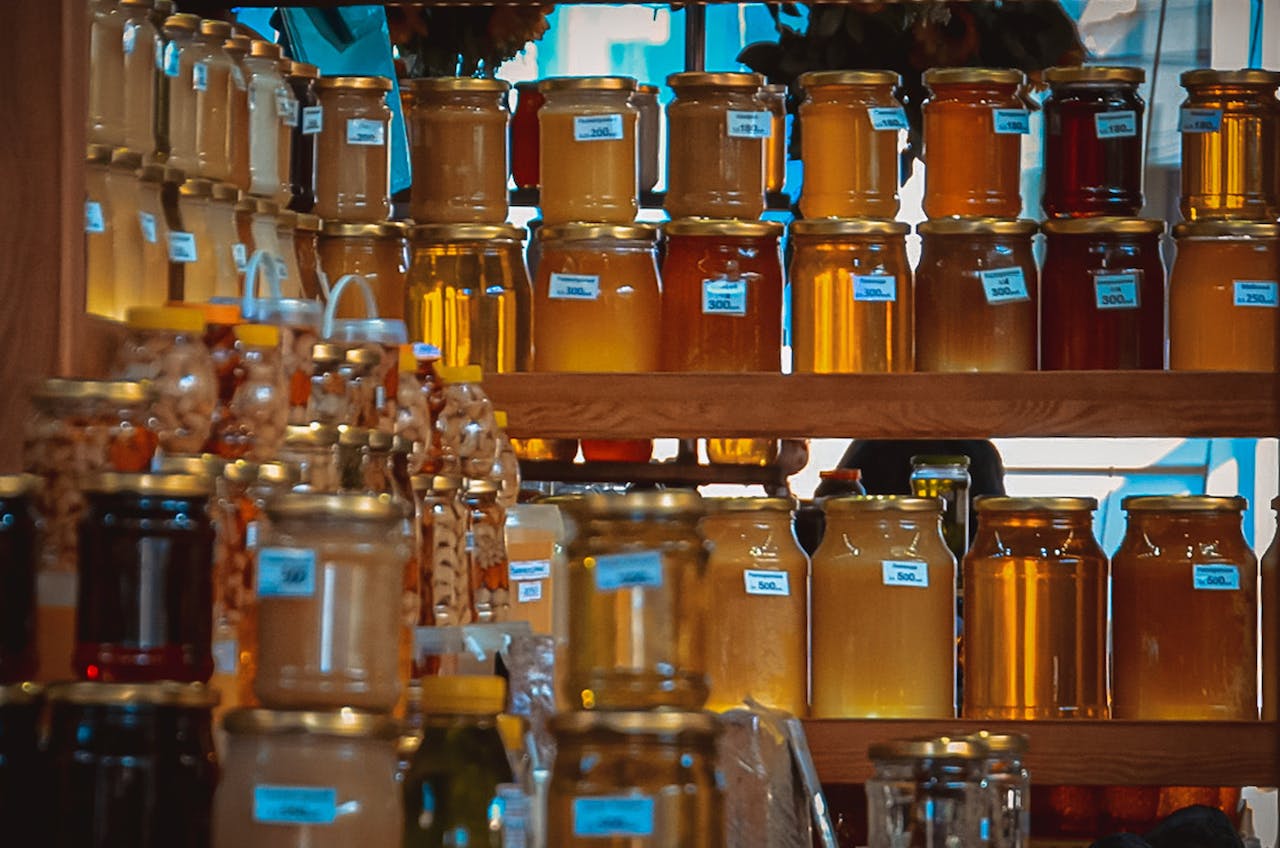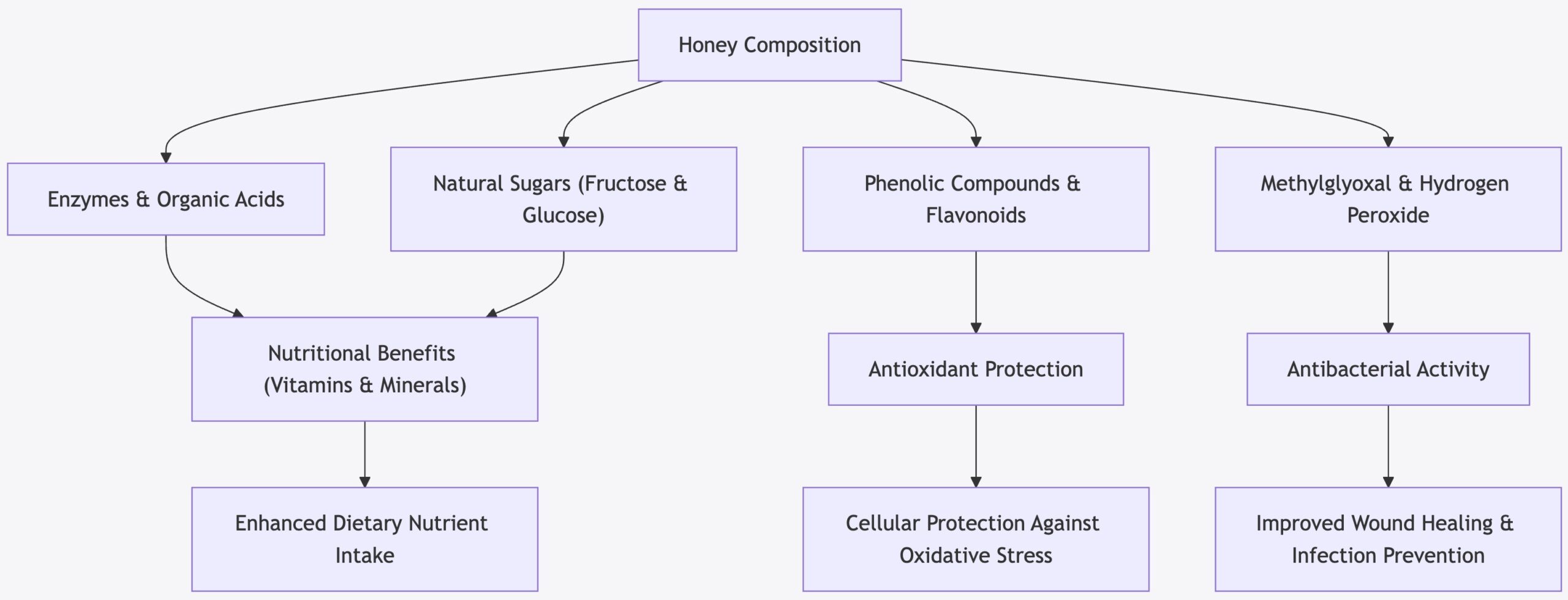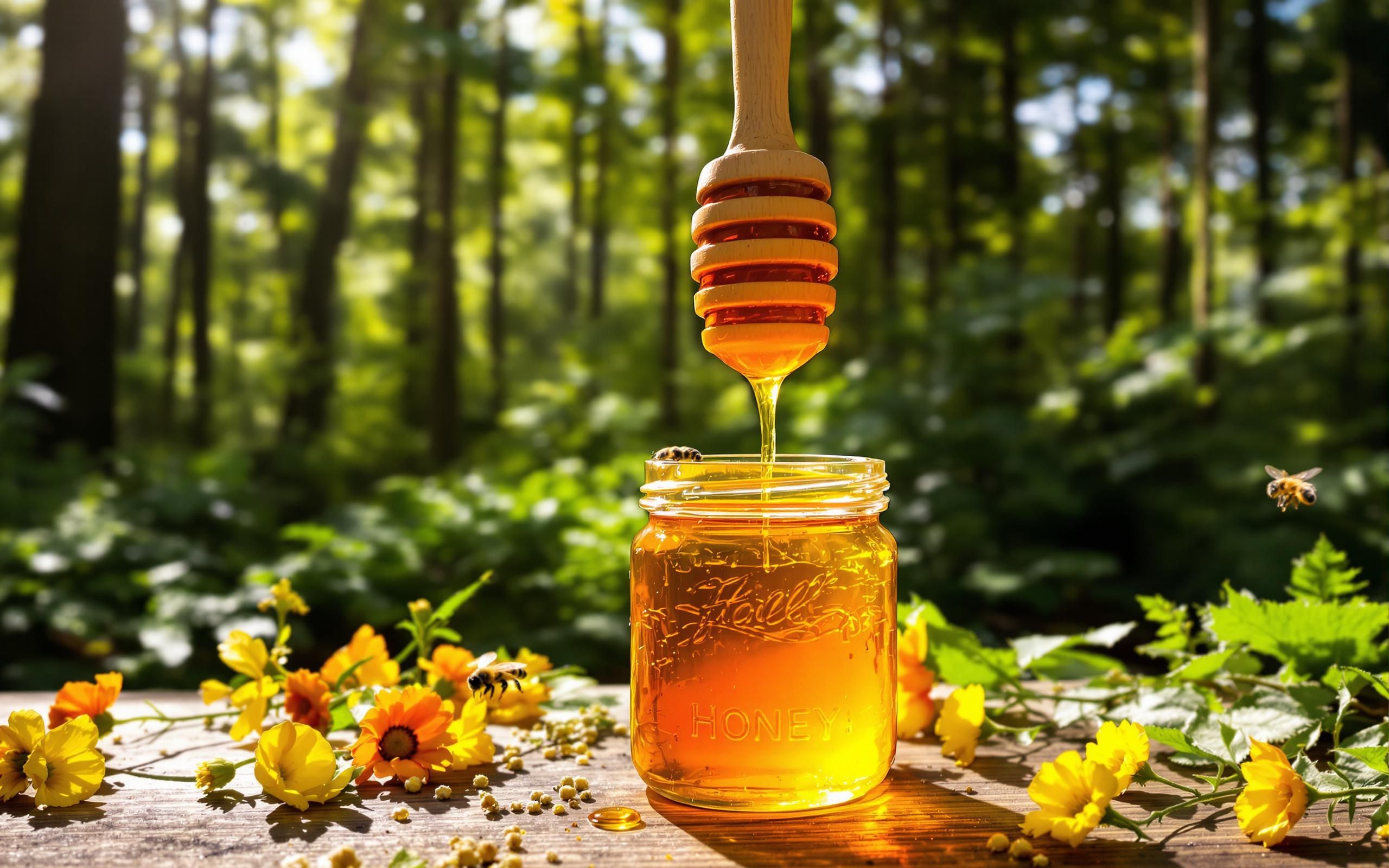Table of Contents
- Introduction
- Overview of Health Benefits of Honey
- Evaluation Metrics: Antibacterial, Antioxidant, and Nutritional Properties
- Detailed Ranking of Top 10 Healthiest Honeys
4.1 Manuka Honey
4.2 Sundarbans Honey
4.3 Buckwheat Honey
4.4 Tualang Honey
4.5 Millefiori Honey
4.6 Cuban Monofloral Honey
4.7 Wild Carrot Honey
4.8 Acacia Honey
4.9 Clover Honey
4.10 Malaysian Wildflower Honey - Comparative Visualization: Metrics Comparison Table
- Process Flow of Health Benefits in Honey (Mermaid Diagram)
- Usage Recommendations and Safety Considerations
- Conclusion and Summary of Key Findings
1. Introduction
Honey has been esteemed by cultures worldwide not only for its natural sweetness but also for its potential medicinal properties. This article provides a comprehensive analysis and ranking of the top 10 healthiest honey varieties. The ranking is based on three key criteria: antibacterial activity, antioxidant levels, and overall nutritional content. Recent studies and evaluations have affirmed that the beneficial properties of honey largely depend on its floral origin, processing methods (raw vs. pasteurized), and the presence of bioactive compounds such as phenolic compounds, enzymes, and amino acids. With the growing demand for natural health supplements, understanding the comparative benefits of different types of honey is more important than ever. In the sections that follow, each honey variety is discussed with reference to measured properties and supporting peer-reviewed evidence.
2. Overview of Health Benefits of Honey
Honey is primarily composed of sugars (mostly fructose and glucose), water, proteins, enzymes, vitamins, and minerals. It also contains a wide array of phenolic compounds—which serve as powerful antioxidants—and exhibits broad-spectrum antibacterial and anti-inflammatory properties. The quality and effectiveness of honey as a nutraceutical are influenced by its level of processing. Raw honey, which is minimally processed, tends to retain higher levels of natural enzymes, antioxidants, and beneficial phytochemicals compared to pasteurized versions. Despite its high caloric content, its potent biologically active components have made honey a subject of countless studies aimed at its use in wound healing, digestive health, and even as a potential adjunct to conventional therapies.
Important facets of honey’s health benefits include:
- Antibacterial Activity: Certain honeys are known to inhibit the growth of pathogenic bacteria. For example, Manuka honey, renowned for its high methylglyoxal (MGO) content, is clinically recognized for wound healing and infection prevention.
- Antioxidant Capacity: Many honeys are rich in phenolic compounds, which help combat oxidative stress by neutralizing free radicals. Buckwheat and dark-colored monofloral honeys typically exhibit higher antioxidant levels.
- Nutritional Value: The inherent vitamins and minerals found in honey, though in modest amounts per serving, contribute to its nutritional profile. Nutrients such as calcium, iron, and zinc are present in certain varieties and add value beyond mere sweetening.
These attributes, among others, form the basis for the subsequent ranking detailed in this article.
3. Evaluation Metrics: Antibacterial, Antioxidant, and Nutritional Properties
To rank the honeys comprehensively, the analysis herein hinges on three main metrics:
- Antibacterial Properties:
Antibacterial efficacy is determined by the presence of active compounds such as hydrogen peroxide, methylglyoxal (MGO), and other phytochemicals. Some varieties, notably Manuka honey, have demonstrated exceptional efficacy against pathogens such as Staphylococcus aureus and Escherichia coli. The ability of honey to fight bacterial infections has been attributed to its low pH, osmotic effect, and the presence of bioactive compounds. - Antioxidant Levels:
The antioxidant capacity of a honey is primarily linked to its phenolic content and flavonoid composition. The measured total phenolic content, expressed in mg of gallic acid per kg, is a key indicator of antioxidant potential. For example, studies have shown that Manuka honey exhibits one of the highest phenolic contents among comparative varieties (approximately 899.09 mg gallic acid/kg). Buckwheat honey and other dark honeys also show significant antioxidant strengths, which can help mitigate oxidative stress and age-related cellular damage. - Nutritional Content:
Although honey is predominantly a source of sugars, its nutritional benefits extend to providing trace amounts of vitamins, minerals, and amino acids. Monofloral honeys, which derive predominantly from one floral source, typically have a higher concentration of specific nutrients compared to multifloral variants. For instance, clover and Acacia honeys are known for their mineral content, including calcium, iron, and potassium, making them useful as components of a balanced diet.
By integrating these metrics, the ranking ranked below seeks to provide a balanced overview of the health benefits associated with each variety.
4. Detailed Ranking of Top 10 Healthiest Honeys

In this section, each honey variety is explored in depth. The ranking not only recognizes the superior bioactive compounds but also considers traditional usage and regional evaluations based on rigorous scientific studies.
4.1 Manuka Honey
Origin: New Zealand
Key Attributes:
- Phenolic Content: Manuka honey stands apart with an impressive total phenolic content of approximately 899.09 mg gallic acid/kg, offering robust antioxidant capacity.
- Antibacterial Activity: Its unique non-peroxide activity attributed to methylglyoxal (MGO) makes it highly effective against multi-resistant bacteria, significantly aiding in wound healing processes.
- Nutritional Profile: Although calorically dense, Manuka honey is valued for its consistent and potent bioactive composition.
Manuka honey’s proven efficacy in clinical settings makes it the top-ranking variety for both its antibacterial and antioxidant properties.
4.2 Sundarbans Honey
Origin: Bangladesh (Sundarbans region)
Key Attributes:
- Proline Content: Sundarbans honey has been found to exhibit exceptionally high levels of proline (approximately 1,714.54 ± 591.2 mg/kg), which serves as an indicator for optimal maturity and may contribute to its enhanced antioxidant activity.
- Overall Quality: Evaluations have highlighted its superior antioxidant capacity along with a balanced nutritional profile that meets international quality standards.
- Antibacterial and Nutritional Benefits: This variety provides an excellent combination of antibacterial efficacy (stemming from its unique natural composition) and desirable nutritional benefits, making it an ideal choice for health-conscious consumers.
Sundarbans honey is notable for its ability to deliver both potent antioxidant protection and supportive nutritional values.
4.3 Buckwheat Honey
Origin: Global (prominently in regions where buckwheat is cultivated)
Key Attributes:
- Antioxidant Boost: Buckwheat honey has been documented to increase serum antioxidant capacity in humans, underscoring its significant polyphenol content.
- Antibacterial Efficacy: While its antibacterial properties may be slightly less pronounced than those of Manuka honey, the high antioxidant capacity plays a central role in combating oxidative stress and inflammation.
- Nutritional Contribution: Its darker color often signifies richer nutrient density, including trace minerals that contribute to overall health.
Buckwheat honey is highly valued as a natural antioxidant booster, providing health benefits that offset its higher-calorie content.
4.4 Tualang Honey
Origin: Malaysia
Key Attributes:
- Phenolic Concentration: Tualang honey is recognized for its higher phenolic content compared to many other local honey varieties and exhibits strong radical scavenging activity.
- Traditional Applications: Traditionally used for wound care and to alleviate inflammatory conditions, it has earned a reputation for its healing properties.
- Enzymatic Activity: Its robust enzymatic profile contributes further to its overall antibacterial effectiveness and enhanced nutritional quality.
The efficacy of Tualang honey in traditional medicine is now supported by scientific data, solidifying its place as a top contender in this ranking.
4.5 Millefiori Honey
Origin: Italy
Key Attributes:
- Antioxidant Richness: Millefiori honey, particularly in its raw form, is renowned for being stuffed with antioxidants—mainly in the form of polyphenols and flavonoids—which are largely preserved due to minimal processing.
- Antibacterial Properties: Its natural enzymatic activity further supports its role in inhibiting bacterial growth, making it a beneficial option for both internal consumption and topical application on wounds.
- Nutritional Integrity: As a raw product, Millefiori honey maintains its nutritional and bioactive compounds without the degradation associated with pasteurization.
Millefiori honey’s raw status allows for maximum retention of active compounds that contribute to its overall health benefits.
4.6 Cuban Monofloral Honey
Origin: Cuba
Key Attributes:
- Broad-Spectrum Antimicrobial: Cuban monofloral honey demonstrates potent antibacterial activity against a range of organisms, including Gram-positive and Gram-negative bacteria, partly due to its hydrogen peroxide production.
- Antioxidant and Nutritional Profile: Although its composition varies, the consistency in its antimicrobial properties across different batches emphasizes its reliability as a natural antibiotic.
- Therapeutic Uses: Its long history of use in local folk medicine further supports its role in natural therapy protocols.
The natural antimicrobial effects demonstrated by Cuban monofloral honey make it an invaluable addition to the top 10 list, especially for applications in modern integrative medicine.
4.7 Wild Carrot Honey
Origin: Algeria
Key Attributes:
- Floral-Specific Properties: Wild carrot honey is derived from the nectar of wild carrot plants and exhibits moderate phenolic content, which is reflected in its notable antioxidant activity.
- Traditional Medicinal Use: Historically, this variety has been used in traditional medicine practices in Algeria due to its beneficial bioactive profile.
- Balanced Nutrient Composition: Although not as potent as Manuka in any single category, its overall balanced quality makes it a viable option among health-oriented honeys.
Wild Carrot honey offers a combination of modest antibacterial and antioxidant activities with a unique floral signature that distinguishes it from more mainstream varieties.
4.8 Acacia Honey
Origin: Germany (and other regions worldwide)
Key Attributes:
- Mild Flavor and Low Glycemic Index: Acacia honey is prized for its light, mild flavor and low glycemic index, making it suitable for individuals managing blood sugar levels.
- Antioxidant Profile: It contains a healthy level of antioxidants, though not as concentrated as those in darker honeys, and offers a subtler flavor profile that appeals to a wide range of consumers.
- Nutrient Balance: The steady presence of minerals and trace nutrients, including calcium and iron, further boosts its nutritional appeal.
Acacia honey’s low glycemic index and mild taste allow it to serve as an excellent natural sweetener without a significant impact on blood sugar levels.
4.9 Clover Honey
Origin: Global (with notable production in North America and Europe)
Key Attributes:
- Nutrient-Rich Profile: Often referred to as a “monofloral” honey (when derived predominantly from clover nectar), this variety is rich in essential minerals such as calcium, iron, magnesium, and zinc.
- Energy-Boosting Properties: The high glucose content makes it an excellent natural energy booster, which is beneficial for athletes and active individuals.
- Mild Antimicrobial Activity: While its antibacterial properties are not as pronounced as those found in Manuka or Tualang, clover honey still offers mild antimicrobial effects along with a pleasant flavor that appeals to many consumers.
Owing to its broad availability and nutritional benefits, clover honey remains a popular choice as a daily supplement and natural sweetener.
4.10 Malaysian Wildflower Honey
Origin: Malaysia
Key Attributes:
- Diverse Polyphenol Profile: Malaysian wildflower honey benefits from the diverse floral sources available in the region, resulting in a rich diversity of polyphenols and other bioactive compounds.
- Antibacterial and Nutritional Advantages: Research indicates that this variety is effective against specific bacterial strains, such as Pseudomonas aeruginosa, while simultaneously providing valuable amino acids and enzymes.
- Complementary Role in a Balanced Diet: Its complex flavor and robust nutritional profile make it an appealing option for individuals seeking both therapeutic benefits and a gourmet honey experience.
Malaysian wildflower honey rounds out the top 10 list with its unique floral composition and comprehensive profile of antibacterial, antioxidant, and nutritional properties.
5. Comparative Visualization: Metrics Comparison Table
The following table summarizes the key attributes of each honey variety, integrating their antibacterial potency, antioxidant capacity, and nutritional content:
| Rank | Honey Type | Origin | Key Antibacterial Feature | Antioxidant Metric/Key Indicator | Notable Nutritional Aspect | Citation |
|---|---|---|---|---|---|---|
| 1 | Manuka | New Zealand | Methylglyoxal (MGO) confers strong non-peroxide activity | Highest phenolic content (~899.09 mg/kg) | Consistent bioactive enzyme and nutrient profile | |
| 2 | Sundarbans | Bangladesh | Broad-spectrum microbial inhibition | Extremely high proline (1,714.54 mg/kg) | High overall quality meeting international standards | |
| 3 | Buckwheat | Global | Natural inhibition via osmotic pressure | Significant serum antioxidant boosting | Rich in polyphenols and darker pigments | |
| 4 | Tualang | Malaysia | Notable activity in wound healing | Elevated phenolic content with radical scavenging | Traditional efficacy with robust enzyme activity | |
| 5 | Millefiori | Italy | Retained enzymatic antibacterial properties | Packed with antioxidants (polyphenols, flavonoids) | Raw honey status preserves nutritional integrity | |
| 6 | Cuban Monofloral | Cuba | Hydrogen peroxide-driven antimicrobial action | Moderate antioxidant levels | Consistent traditional therapeutic use | |
| 7 | Wild Carrot | Algeria | Mild antibacterial activity | Moderate phenolic levels | Unique floral signature with balanced nutrients | |
| 8 | Acacia | Germany | Suitable for diabetic diets due to low glycemic load | Contains subtle antioxidants | Rich in minerals (calcium, iron, potassium) | |
| 9 | Clover | Global | Mild antimicrobial effect | Provides essential trace antioxidants | High in essential minerals and energy-boosting sugars | |
| 10 | Malaysian Wildflower | Malaysia | Effective against P. aeruginosa | Diverse polyphenol profile | Rich in amino acids and beneficial enzymes |
Table: Comparative analysis of health-promoting properties of top 10 honey varieties.
6. Process Flow of Health Benefits in Honey (Mermaid Diagram)
Below is a flowchart representing the process flow from honey composition to its health benefits. The diagram illustrates how key components of honey contribute to antibacterial, antioxidant, and nutritional properties.

Figure: Flowchart depicting the pathways through which honey components contribute to its health benefits.
7. Usage Recommendations and Safety Considerations
While the top 10 healthiest honeys offer impressive benefits, it is essential to consider proper usage guidelines and safety precautions:
- Wound Healing:
Varieties like Manuka and Tualang honey are particularly effective when applied topically for wound care and burn treatment. Their potent antibacterial properties help prevent infection and promote tissue regeneration. - Antioxidant Supplementation:
Consuming dark and raw honeys, such as Buckwheat, Millefiori, and Sundarbans, can help bolster antioxidant defenses in the body. This is particularly beneficial for individuals under oxidative stress or those at risk for age-related degenerative diseases. - Dietary Integration:
Honeys like Acacia and Clover serve as excellent natural sweeteners. Their lower glycemic index and higher mineral contents support a balanced diet without significant blood sugar spikes, making them suitable for individuals with dietary restrictions. - Safety Considerations:
- Infant Consumption:
Do not serve any form of honey to infants under 12 months because of the risk of botulism from Clostridium botulinum spores. - Allergic Reactions:
Raw honey might contain traces of pollen that can trigger allergies in susceptible individuals. - Processing Effects:
Pasteurization, while extending shelf life, can reduce the concentration of important enzymes and antioxidants. When seeking maximum health benefits, choose raw or minimally processed honey products.
- Infant Consumption:
By understanding these recommendations and precautions, consumers can effectively integrate these superior honey varieties into their wellness routines.
8. Conclusion and Summary of Key Findings
This comprehensive analysis has ranked the top 10 healthiest honeys based on a meticulous evaluation of antibacterial, antioxidant, and nutritional properties. The ranking underscores the following key insights:
- Manuka Honey is the gold standard with its exceptional phenolic content and distinct antibacterial efficacy through methylglyoxal, making it ideal for medical applications and wound care.
- Sundarbans Honey excels in antioxidant capacity due to its high proline content and overall quality, offering a powerful supplement for oxidative stress management.
- Buckwheat Honey is lauded for its ability to increase serum antioxidant capacity and combat oxidative damage, a vital benefit for promoting long-term health.
- Tualang Honey stands out as a traditional remedy with high phenolic content, reinforcing its longstanding use in wound care and anti-inflammatory therapy.
- Millefiori Honey’s raw, unprocessed nature ensures maximum retention of bioactive compounds, thus providing robust nutritional and antibacterial benefits.
- Cuban Monofloral Honey leverages natural hydrogen peroxide production to exhibit broad-spectrum antimicrobial effects, reflecting its consistent use in folk medicine.
- Wild Carrot Honey offers balanced benefits with moderate antioxidant properties and a distinct floral profile reflective of its Algerian origin.
- Acacia Honey caters to dietary needs with its low glycemic index and rich mineral content, making it especially attractive for health-conscious populations.
- Clover Honey provides an energy-boosting option loaded with essential trace minerals and moderate antioxidant levels, widely recognized for its nutritional benefits.
- Malaysian Wildflower Honey rounds out the list with its diverse polyphenol profile, effective antibacterial properties, and significant amino acid content, reflecting the region’s rich botanical diversity.
Summary Bullet List of Main Findings
- Antibacterial Efficacy:
- Manuka honey demonstrates superior antibacterial activity due to high MGO levels.
- Cuban monofloral and Tualang honeys also contribute significant antimicrobial benefits.
- Antioxidant Capacity:
- High phenolic content in Manuka, Buckwheat, and Tualang honey provides powerful free radical scavenging effects.
- Sundarbans honey is notable for its high proline level, correlating with excellent antioxidant capacity.
- Nutritional Content:
- Monofloral honeys such as Acacia and Clover deliver higher levels of essential vitamins and minerals.
- The overall nutrient profile of these honeys supports dietary health when consumed in moderation.
- Usage and Safety:
- Raw honey is preferable for preserving enzyme activity and antioxidants.
- Special caution is needed when administering honey to infants and individuals with pollen-related allergies.
In summary, this ranking benefits both consumers and healthcare practitioners by providing clear guidance on which honey varieties may offer the greatest health benefits. The integration of scientific evaluation with traditional use reinforces honey’s status as a valuable natural product with significant therapeutic potential.
By closely reviewing the supporting studies and scientific evaluations, this article has provided an evidence-based ranking that empowers informed choices for those seeking the healthiest honey options. Each variety is unique, and the best choice may vary depending on individual health needs and applications. Always ensure that honey products are authentic and, whenever possible, opt for raw varieties to maximize their health-promoting properties.



 15 Most Healthiest & Nutritious Dishes Worldwide
15 Most Healthiest & Nutritious Dishes Worldwide





